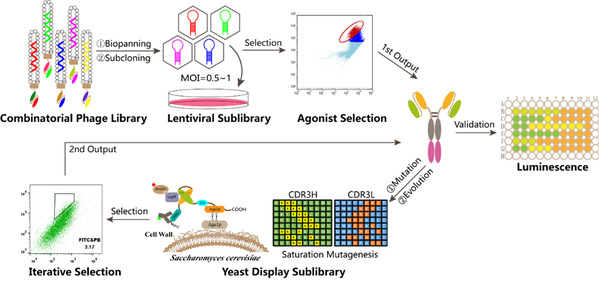Since developed in 1980s by Prof. Richard Lerner and Prof. Gregory Winter, 2018 Nobel Laureate in Chemistry, combinatorial antibody library technology has been applied in biomedical development and basic science research, etc. Prof. Richard Lerner extended the application of combinatorial antibody to many fields, such as enzyme catalysis, receptor activation and cell fate regulators. Recently, a joint team led by Profs. Richard Lerner and Yang Guang discovered an agonist antibody targeting leptin receptor from combinatorial antibody and published their findings in Advanced Science on July 1st, entitled “Selection of a Full Agonist Combinatorial Antibody that Rescues Leptin Deficiency In Vivo”.
Leptin is an important protein metabolic regulator and it is mainly secreted by white adipose tissue of the body. Leptin can stimulate POMC and AgRP neurons, which express leptin receptor in the arcuate nucleus of the hypothalamus to regulate the body's appetite and energy metabolism. Leptin receptor belongs to the type I cytokine receptor family and the JAK-STAT pathway is its primary signaling.Leptin is a multi-function cytokine with many targeting organs. In addition to the regulation of energy metabolism, leptin also has many other important physiological functions, including immune regulation, reproductive system development, bone density regulation, nerve cell protection and tumorigenesis. Patients with leptin gene deficiency were clinically manifested as obesity, exuberant appetite, hyperinsulinemia, hyperlipidemia, and reproductive and immune dysfunction. The recombinant leptin has been approved in the United States, Europe and Japan for the treatment of patients with congenital or acquired systemic fat metabolism disorders that are complications of leptin deficiency. However, although recombinant leptin can effectively treat leptin deficiency in the body, the drug has a short half-life and immunogenicity, which may lead to the emergence of anti-drug antibodies and loss of therapeutic effect or severe infection.
The joint team led by Profs. Yang Guang and Richard Lerner established a full agonist screening and optimization system by targeting leptin receptors with human combinatorial antibody libraries, where Phage display, mammalian cell membrane display, and yeast surface display were integrated to select leptin receptor-specific agonist antibody H6. In vitro, the selected antibody H6 was proved to specifically activate the leptin receptor of both human and mice, and the receptor activation by the antibody H6 is consistent with the natural ligand leptin. In vivo, leptin deficient mice (ob/ob), leptin receptor deficient mice (db/db), wild type mice and diet-induced obesity mice (DIO) were used to verify the efficacy of antibody. The results indicated that antibody H6 could enter the hypothalamus region to stimulate neurons expressing leptin receptor to regulate diet and body weight of mice. Meanwhile, animal results also showed that antibody H6 has longer half-life and better biological activity than the natural leptin. In addition, antibody H6 and leptin may activate the receptor in different mechanism. H6 antibodies can effectively activate the mutant leptin receptors that have no response to leptin. Therefore, antibody H6 has the potent to treat obese patients with leptin mutant receptors.
Graduate student Tao Pingdong from Yang Guang’s group is the first author of this article. Professors Richard Lerner and Yang Guang are the corresponding authors. SIAIS is the primary affiliation for this study. The work was supported by the National Natural Science Foundation of China and the Shanghai Municipal Science and Technology Commission. Several technical platforms of SIAIS provided important support for this study.

Fig.1 Full agonist antibody selection system targeting leptin receptor

Fig.2 Evaluation of antibody H6 and Leptin in ob/ob mice
Link to the original paper:
https://onlinelibrary.wiley.com/doi/full/10.1002/advs.202000818



